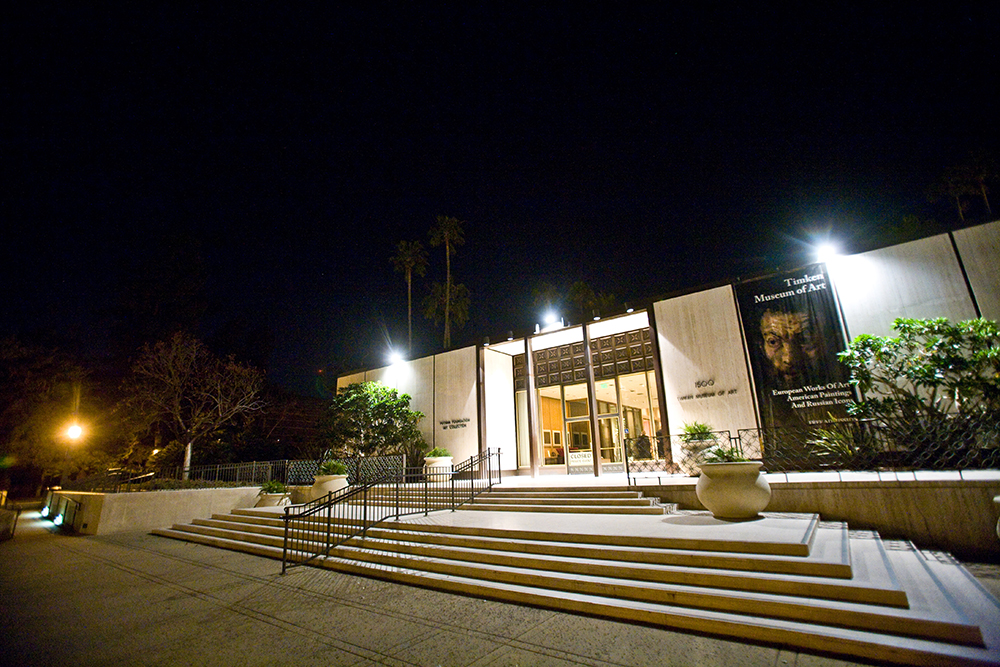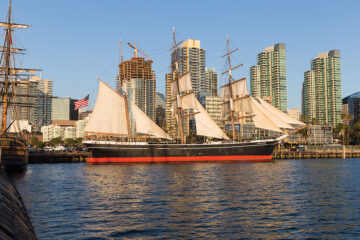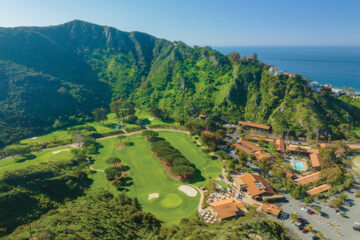The Timken Museum of Art features some of the finest European and American masterworks
Among the many museums in Balboa Park, the Timken Museum of Art is notable not only for its remarkable collection but for the fact that it is free to attend.

Among the many museums in Balboa Park, there is one that is notable not only for its remarkable collection but for the fact that it is free to attend. That, of course, is the Timken Museum of Art, a gift to San Diego from two families where visitors are truly free to enjoy the finest European and American masterworks at their pleasure.
Those two families are the Timkens and the Putnams, and their dedication to sharing with the San Diego community remains central to the vision of Executive Director Megan Pogue, who came to the museum in 2015 following more than a decade with San Diego Symphony.
“We are committed to providing free art experiences for everyone and to attracting new audiences,” Pogue says, pointing to the fact that the Timken is not only free, it is small. There is nothing daunting in the prospect of a visit to the Timken, making it in Pogue’s words “the perfect entry point for those less experienced with art.” If scheduling is an issue, the entire museum can be enjoyed in an hour or less — an important consideration in that strollers are welcome and there is a new children’s activity center.
With the belief that no one is too young or too old to experience great art, the museum works with area schools, including some in Tijuana, to bring in elementary, middle, and high school students for docent-guided tours. The museum also works with senior facilities to host older people who can’t make it on their own.
Once they come through the doors, all who enter find themselves in one of the finest small museums in the country. Along with the only Rembrandt on permanent display in San Diego, the collection includes many of the greatest names in European and American Art — from Rubens, Zurbaran, and Van Dyck to Albert Bierstadt, Eastman Johnson, Fitz Henry Lane, and George Inness.
Somewhat ironically, given the building’s design, there are many in San Diego who have likely walked past never knowing precisely what is inside. In sharp contrast to Balboa Park’s mainly Spanish-inspired architecture, the Timken is an example of mid-century modern and there were many who opposed it on aesthetic grounds. Not only did it conflict with the surrounding buildings, there was nothing in its appearance to suggest the kind of works it held, something that is no longer possible. Under Pogue, banners on the front of the building now boldly display both masterworks and the names of the artists whose creations are to be found within. It is part of Pogue’s desire to bring the art outside, something she hopes to do at the rear of the building as well, which faces the beloved lily pond.
Jewels of the Season
The idea is to get people thinking: “Let’s take a look,” and, not surprisingly, in the past five years the number of annual visitors has jumped from 175,000 to 275,000. A sizeable portion of that increase can be attributed to Jewels of the Season, the museum’s tribute to a collection of holiday ornaments handcrafted over a period of 80 years by San Diego artisans Florence Hord and Elizabeth Schlappi.
Together, Hord and Schlappi created more than 1,400 ornaments of such exquisiteness they have been compared to Fabergé eggs. Each ornament required days if not weeks to complete and the museum has been displaying them on its holiday tree since 1988.
Jewels of the Season, however, is much more than stunning holiday ornaments. It is a multimedia installation created in partnership with the San Diego State University School of Theatre, Television and Film, and MSI Production Services. It includes everything from music to model trains courtesy of Timken neighbor the San Diego Model Railroad Museum. Since its inception in 2016, this now famous San Diego holiday tradition, which this year opens on November 22, has seen attendance grow from 18,000 to 35,000.
The Jewels of the Season exhibit fills the Timken’s central gallery during the holidays, but at other times the central gallery is home to the museum’s artist-in-residence program, during which a local artist is invited to create a Modernist installation interpreting one of the museum’s works.
Artists in Residence
This past summer the Timken hosted Roman de Salvo, who often incorporates active elements in his works, such as wind, water, fire, electricity, and audience participation. His piece for the Timken, Electric Picnic, is no exception. Inspired by Honoré Fragonard’s Blind man’s Bluff from the museum’s permanent collection, de Salvo focused specifically on the painting’s backdrop, a gnarled, branching tree. For material, he used pieces that looked to be taken from a large erector set, and at first glance Electric Picnic could have been mistaken for an engineering project. De Salvo’s real interest, however, was biology and the notion of bifurcation, or the branching into two segments, a common occurrence in trees, plants, humans, and countless other aspects of the natural world.
These artist residencies are a way for the Timken to meld its historic collection with new works and at the same time to enable visitors to observe artwork as it takes form. De Salvo took two months to complete Electric Picnic, while last summer it was a large paper installation based on Veneto’s Portrait of a Lady by Indian-American artist Bhavna Mehta.
“We’ve been working hard on the visitor experience,” Pogue says, “providing more information on the works and hosting gateway events to bring people in.”
Additional Offerings
Given the importance of the collection, the Timken has for years hosted international scholars to speak on the museum’s works, but last year it initiated a new Music & Masters program, which this year takes place on November 17 from 5:30 to 8:00pm. The theme is The Heritage of Harmony, an evening of music performed by two of San Diego’s finest musicians — violinist Nuvi Mehta, who serves as concert commentator for the San Diego Symphony; and pianist Bryan Verhoye. Including works by Bach, Chopin, Ravel, and Gershwin, the evening includes hors d’oeuvres and refreshments.
The museum also hosts Wine & Masters events, during which a sommelier might discuss the wines Rembrandt and other artists might have drunk — wine and art of course going hand in hand.
The aim in all of this is to educate, excite, and provide experience, or as Pogue refers to them, “the three Es.”
Along with its European and American masterworks, the Timken is also home to an important collection of Russian icons and tapestries, an assemblage more typical of East Coast venues. Some compare it to the world-famous Frick collection in New York and many of the works now at the Timken have spent significant time at the Metropolitan Museum of Art in New York and the National Gallery of Art in Washington, D.C., a story that bears telling in terms of its history.
A Brief History
The Timken is named for the Timken family of Canton, Ohio, who wintered in San Diego. They were principal benefactors of the Fine Arts Society, now the San Diego Museum of Art, which like many of the Park’s great cultural institutions was an outgrowth of the great Panama-California Exposition of 1915.
The collection it houses, however, was purchased by two women, Anne and Amy Putnam, sisters who arrived in San Diego with their parents in the early 1900s. They had an inventor uncle who made a fortune on patents for bottle caps, carpet tacks, safety pins, and the production of barbed wire. His son, the women’s cousin, never married and when he died, a quarter of the family fortune passed to Anne and Amy, who for both tax reasons and the love of art became two of San Diego’s greatest patrons of the arts.
Starting in the 1930s they began purchasing European masterworks, which they would then donate anonymously to the city’s recently founded Fine Arts Society. It was an arrangement that lasted until sometime around 1950 by which time the Fine Arts Society, with works by Giotto, Giorgione, El Greco, Goya, and many others, was considered the finest collection of Old Masters in the Western United States.
A Falling Out
All the specifics are not known, but around this time the sisters had a major falling out with the Society’s director, Reginald Poland, an experienced art historian with degrees from both Princeton and Harvard who had held major posts at museums in Denver and Detroit prior to relocating to San Diego for the opening of the Fine Arts Gallery in 1926.
What is known is that the issues involved a second man, Jacob Heimann, a Russian Jewish art dealer who had moved to the United States and settled in Beverly Hills in response to the rise of antisemitism and war in Europe. Heimann had many contacts and ingratiated himself with the aging, unmarried sisters. In 1950, Anne, then 82, had begun to suffer from Alzheimer’s disease and had a court-appointed guardian within the year, while Amy, the younger of the two, was sending daily letters and telegrams to her trust officer in New York, raving about Poland’s “evils,” which related to putting Putnam-acquired paintings in storage when the gallery was holding exhibitions of modern art or local artists.
Neither sister visited the museum between 1949 and 1951, and ultimately Poland was forced to resign. Heimann, himself, was later investigated and dismissed as well for questionable dealing, but in the meantime the sisters broke ties with the Fine Arts Society and established a separate foundation and collection.
The new foundation was ostensibly established to facilitate the charitable giving required by the Putnam trust, but the effect was that new acquisitions by the sisters no longer went to the Fine Arts Gallery. Instead they were loaned to the Metropolitan Museum of Art, the National Gallery of Art, and other major museums around the country.
This is to some extent where the Timkens come in, though in fact they were there from the start as original benefactors of the Fine Arts Society. The land to the east of the Fine Arts Gallery was earmarked for its future expansion, and in 1957 then-director Warren Beach travelled to New York to ask Lillian Timken to provide funds for a new wing to reunite the Putnam acquisitions, along with a significant collection of paintings she herself owned. Lillian Timken was the 75-year-old widow of William R. Timken, patriarch of a significant industrial empire founded by Henry Timken, a German immigrant to Canton Ohio who retired to San Diego and passed here in 1909.
It was during that time his family members began to winter in San Diego as well, beginning a connection with the city that continues to this day. In 1957, the eccentric Mrs. Timken was living alone in a 24-room apartment on Park Avenue, having dismissed all her servants. She did have a miniature Doberman named Stormy, and a collection of paintings that included Titian, Rubens, Rembrandt, and others. Unfortunately when Mrs. Timken died in 1959 it was discovered that she owed a fortune in taxes, and except for Portrait of a Lady with a Parrot, attributed to Goya, all those other wonderful paintings were seized by federal and state authorities in lieu of taxes and now hang either at the Met or the National Gallery.
Along with no paintings, in San Diego there was also no money for the new wing. Still, while Lillian Timken could no longer be of help, the Timken family remained strong financially and in their support of the arts. By the early 1960s the sisters’ attorney, Walter Ames, had secured funding from other Timken family members for an entirely separate museum and building in the same location that had been earmarked for expansion of the Fine Arts Gallery.
There was some controversy in this as there was in the design of the new building, though all of that is now long in the past. For most, the understatement of the Timken Museum’s design and the quality of the materials used throughout serves to highlight the quality of works within. And as for the relationship between the Timken and its neighbor — despite all that had happened, when the Timken opened in 1965, what was then the Fine Arts Gallery and now the San Diego Museum of Art lent a group of its own most important Putnam purchases for the occasion.
At the time, critic James Britton was quoted in San Diego Magazine as saying, “There probably isn’t another art museum in the country that would have moved over for the Putnam Foundation as gracefully as did the San Diego Fine Arts Society.”
It is written that Britton did not mean it as a compliment, but for those of us here a half century later the pleasure is ours. When it comes to fine art in San Diego, the two collections in many ways complement each other. Indeed, given their proximity and the fact that the Timken is free, there’s no reason not to pay a quick visit on the way in or out of the Museum of Art. Or if you just happen to be at the Lily Pond.
There isn’t much in this world that’s free. Fortunately for San Diego, the Timken Museum of Art is one of them. 619.239.5548, timkenmuseum.org













Comments